I have Spring Boot app running on Wildfly 18.0.1. The main purpose of the app is: every 5 minutes run some job. So I make:
TaskScheduler: initialize scheduler
@Autowired
ThreadPoolTaskScheduler taskScheduler;
taskScheduler.scheduleWithFixedDelay(new ScheduledVehicleDataUpdate(), 300000);
ScheduledVehicleDataUpdate: scheduler that runs updater
public class ScheduledVehicleDataUpdate implements Runnable {
@Autowired
TaskExecutor taskExecutor;
@Override
public void run() {
try {
CountDownLatch countDownLatch;
List<VehicleEntity> vehicleList = VehicleService.getInstance().getList();
if (vehicleList.size() > 0) {
countDownLatch = new CountDownLatch(vehiclesList.size());
vehicleList.forEach(vehicle -> taskExecutor.execute(new VehicleDataUpdater(vehicle, countDownLatch)));
countDownLatch.await();
}
}
catch (InterruptedException | RuntimeException e) {
System.out.println(e.getMessage())
}
}
}
TaskExecutor:
@Bean
public TaskExecutor taskExecutor() {
ThreadPoolTaskExecutor executor = new ThreadPoolTaskExecutor();
executor.setCorePoolSize(23);
executor.setMaxPoolSize(23);
executor.setQueueCapacity(5000);
executor.setThreadNamePrefix("VehicleService_updater_thread");
executor.initialize();
return executor;
}
VehicleDataUpdater: main updater class
public class VehicleDataUpdater implements Runnable {
private final VehicleEntity vehicle;
private final CountDownLatch countDownLatch;
public VehicleDataUpdater(VehicleEntity vehicle, CountDownLatch countDownLatch) {
this.vehicle = vehicle;
this.countDownLatch = countDownLatch;
}
@Override
public void run() {
try {
this.updateVehicleData();
}
catch (Exception e) {
System.out.println(e.getMessage());
}
finally {
countDownLatch.countDown();
}
}
public void updateVehicleData() {
// DO UPDATE ACTIONS;
}
}
The issue is that after finish ScheduledVehicleDataUpdate the memory is NOT clearing. It looks like this:

Every step the memory is growing, growing, growing and at unpredictable moment all memory is freed up. And objects from first iteration, and object from last iteration. In the most bad case it takes all available memory (120Gb) and Wildfly crashes.
I have about 3200 VehicleEntity records (lets assume exactly 3200). So I've looked for the VehicleDataUpdater - how much objects there are in memory. After first iteration (when I only started app) it is less than 3200 but not zero - maybe about 3000-3100. And every step it grows but not exactly on 3200 records. That means that some of objects clears from memory but most of them remains there.
Next: normal duration of iteration is about 30sec - 1min. When memory is not clear up and continue growing then each iteration get more and more time: the longest that I saw was 30 minutes. And threads from pool are mostly in "monitor" state, i.e. there are some locks waiting to release. Possibly locks from previous iterations that was not released - and question again - why all memory was not freed up at previous step?
If I execute update in one thread (without taskExecutor, simply vehicleList.foreach(vehicle -> VehicleDataUpdater(vehicle)); ) than I didn't see any memory growing. After update each vehicle memory is cleared.
I didn't find any issues with memory leaks for ThreadPoolTaskExecutor or ThreadPoolTaskScheduler, so I have no idea how to fix it.
What possible ways of not clearing memory after finish scheduler task? How can I look who is locking object after finish? I'm using VisualVM 2.0.1 and didn't find there such possibilities.
EDIT 1:
VehicleService:
public class VehicleService {
private static VehicleService instance = null;
private VehicleDao dao;
public static VehicleService getInstance(){
if (instance == null) {
instance = new VehicleService();
}
return instance;
}
private VehicleService(){}
public void setDao(VehicleDao vehicleDao) { this.dao = vehicleDao; }
public List<VehicleEntity> list() {
return new ArrayList<>(this.dao.list(LocalDateTime.now()));
}
}
VehicleDao:
@Repository
public class VehicleDao {
@PersistenceContext(unitName = "entityManager")
private EntityManager entityManager;
@Transactional("transactionManager")
public List<VehicleRegisterEntity> list(LocalDateTime dtPeriod) {
return this.entityManager.createQuery("SOME_QUERY", VehicleEntity.class).getResultList();
}
}
InitService:
@Service
public class InitHibernateService {
private final VehicleDao vehicleDao;
@Autowired
public InitHibernateService(VehicleDao vehicleDao){
this.vehicleDao = vehicleDao;
}
@PostConstruct
private void setDao() {
VehicleService.getInstance().setDao(this.vehicleDao);
}
}
EntityManager:
@Bean(name = "entityManager")
@DependsOn("dataSource")
public LocalContainerEntityManagerFactoryBean entityManagerFactory() throws NamingException {
LocalContainerEntityManagerFactoryBean em = new LocalContainerEntityManagerFactoryBean();
em.setPersistenceProviderClass(HibernatePersistenceProvider.class);
em.setDataSource(dataSource());
em.setPackagesToScan("MY_PACKAGE");
em.setJpaVendorAdapter(vendorAdapter());
em.setJpaProperties(hibernateProperties());
em.setPersistenceUnitName("customEntityManager");
em.setJpaDialect(new CustomHibernateJpaDialect());
return em;
}